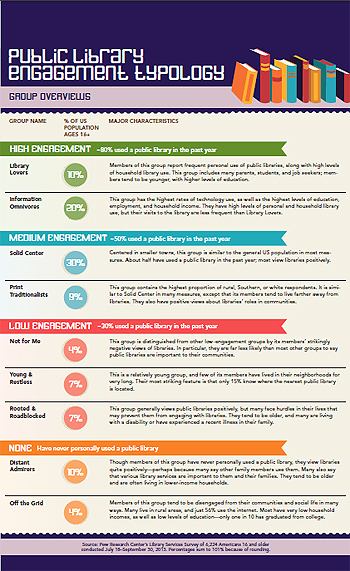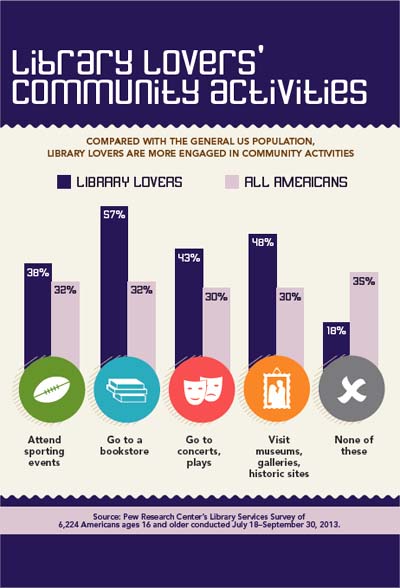The Pew Research Center’s Internet Project has intensively studied the changing world of public libraries for the last three years. The first stage of our research explored the growing role of ebooks, including their impact on Americans’ reading habits and library habits. Our second stage examined the full universe of library services, as well as what library services Americans most value and what they might want from libraries in the future.
In March, we released a report from our third and final stage of research—the fruits of a representative national survey of 6,224 Americans ages 16 and older. It explores public libraries’ roles in people’s lives and in broader American culture—how libraries are perceived, how they are valued, and how people rely on them. The  provision of digital content is certainly a key element of the services that make libraries useful.
provision of digital content is certainly a key element of the services that make libraries useful.
Using the data from our previous report on how people value libraries in their communities, our analysis divides Americans into nine groups that reflect different patterns of public library engagement along a general spectrum of high (30% of the population), medium (39% of the population), low (17% of the population), and nonengagement (14% of the population).
This approach is a little new for us. Our previous reports have explored topics such as what people do at libraries and library websites or how Americans value individual library services based on traditional factors such as gender, race/ethnicity, age, and household income. But this typology moves beyond basic demographic descriptions.
Instead, we used statistical analysis to cluster individuals into groups based on their usage of, views toward, and access to libraries, in order to discover larger insights about how libraries fit into American culture. This type of work more fully embraces the idea that people’s information needs and practices shape their library use as much or more than their skin color, their age, the type of community they live in, or their socioeconomic circumstances.
The table above (PDF) provides an overview of the typology groups.
Looking closer at each stratum of library engagement, we find that the two high-engagement groups, Library Lovers and Information Omnivores, include people who value and utilize public libraries most heavily—those who say that libraries play a major role in their own lives and in the lives of their families, who think libraries improve their communities, who are avid readers and think libraries play an essential role in encouraging literacy and a love of reading. In addition to being highly engaged with libraries, members of these groups also tend to be active in other parts of their communities. They are more likely to know their neighbors, visit museums and attend sporting events, and socialize with families and friends on a regular basis.
On the other hand, those who are less engaged with public libraries may be less engaged in their communities overall. Particularly for the low-engagement groups Not for Me and Rooted and Roadblocked, along with the nonengagement groups Distant Admirers and Off the Grid, lower rates of library use and lack of familiarity with libraries seem to coincide with lower patterns of social and civic engagement in other areas of their lives. Members of low and nonengagement groups are often less likely to participate in similar community activities, such as visiting museums or patronizing bookstores, and more likely to report having difficulty using technology; they also tend to be less comfortable navigating various types of information, such as finding material about government services and benefits.
Other insights in the data
One of the main new insights we get from this kind of analysis is a fuller picture of how people’s lives tie (or don’t tie) to information and communities. There are definitely “information haves” and “information have nots” in the United States. The recurring insight throughout the report is that people’s library habits do not exist in a vacuum. Americans’ connection—or lack of connection—with public libraries is part of their broader information and social landscape.
These patterns are particularly prominent in the high-engagement categories, which contain many of these (often overlapping) groups. In contrast, the low and nonengagement groups tend to be more distinct in the circumstances surrounding their lack of library engagement. For instance, looking only at low-engagement groups (which include people who have used a library at some point in their lives but not recently), there are:
- Not for Me: Respondents who tend to dislike public libraries and are more likely to see them as irrelevant to modern life;
- Young and Restless: Young people who generally feel positively about public libraries but are relatively new to their neighborhoods and unlikely to know where their local library is located;
- Rooted and Roadblocked: Older adults who generally think libraries are good for their community but may have obstacles in their lives, view libraries as somewhat difficult to use, or otherwise think that libraries are not personally relevant to them at this point in their lives.
Beyond the descriptions of individual groups, another common thread in the data is that socioeconomic status is often tied to library engagement in some key respects.
Broadly speaking, adults with higher levels of education and household income are more likely to use public libraries than those with lower household incomes and lower levels of education. However, among those who have used a library in the past year, adults living in lower-income households are more likely to say various library services are very important to them and their families than those living in higher-income households.
These findings echo in several ways:
Life stage and special circumstances are linked to increased library use and higher engagement with information: Deeper connections with public libraries are often associated with key life moments such as having a child, seeking a job, being a student, and going through a situation in which research and data can help inform a decision.
Highly engaged library patrons are also more likely to use newer technologies, including e-readers and tablets: A common narrative is that Americans are turning away from libraries because of newer technology, but the data shows that most highly engaged library users are also big technology users. In fact, members of the groups with the highest levels of library engagement are more likely to own e-readers than most lower-engagement groups, and almost half (46%) of Information Omnivores (the second-highest engagement group) own tablets.
The most intense library users are also the most frequent bookstore visitors: The Library Lovers group represents the most highly engaged users in the typology. Its members are also big readers: Most of them read books daily, and they read an average of 27 books in the past year. And despite their generally higher levels of library use and the fact that most prefer to borrow books rather than purchasing them, 57% say they visit bookstores regularly. That is a higher proportion than any other group.
The most highly engaged library users are most likely to make frequent use of library websites: Roughly eight in 10 members of the highest engagement groups have used a library website in the past year, compared with 30% of the general public. And about half of Library Lovers use one at least once a week.
It has been a great pleasure to work with the library community for the past three years. We hope librarians will find this material useful as they discuss the role of libraries in their communities and make plans for the future.
KATHRYN ZICKUHR is research associate at the Pew Research Center’s Internet and American Life Project. LEE RAINIE is director of the project, which has studied the social impact of digital technologies since 2000.
